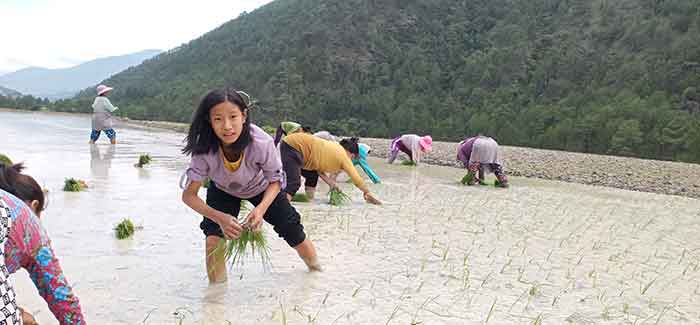About 1,100 acres of agriculture land in Punakha remain fallow
Phurpa Lhamo | Punakha
Kiras raised to their knees, feet dragging in the ankle-deep muddy water, a group of woman are transplanting paddy seedlings. At a distance, a man is on the plough preparing fields. Changla or paddy cultivation has begun in Punakha.
Above the busy fields, Mindum’s fields are neither tilled nor are her paddy seedlings ready. Nine years since she began sharecropping on a three-acre land in Changyul, Punakha, this is the first time Mindum’s field has remained barren.
“I cannot do it any longer. I am giving up paddy cultivation this time,” Mindum said. Her decision has been due to Changyul’s severe irrigation water shortage.
This is not an isolated case as the government reemphasise on the importance of agriculture. There is a renewed focus on agriculture since the Covid-19 pandemic hit Bhutan. Agriculture is seen as an important sector to ensure food self-sufficiency, but also as an alternative for creating jobs.
Punakha grows rice, about half a dozen varieties. When it is not the paddy season, most farmers grow vegetables for cash. There is potential for double cropping, but there are challenges.
About 1,100 acres of agriculture land in Punakha remain fallow. Not many farmers own more than one acre. Many are sharecroppers.
“More people are leaving cultivation because they cannot afford to. And more land remain fallow today,” Mindum said.
The problem of water is not only in Changyul chiwogs. More than half of Punakha’s 11 gewogs have issues with water for irrigation.
According to Guma gup Ugyen Khandu, three of five chiwogs in Guma had water issues. “Villagers are desperately looking for new water sources. And fights during irrigation time is common,” Ugyen Khandu said.
Today, of over 800 households in the gewog, nearly 550 households of the three chiwogs face irrigation water problem.
In the north in the fertile Chubu gewog, about 110 households in Yoebisa, Bali and Nawakha village face irrigation water issues.
The consequence is worrying. The two chiwogs and the village have over 25 acres of fallow land because of not having enough water.
In Dzomi gewog, on the side of the river Phochu, there is no source of irrigation water. Water is channelled from the Shelnga rongchu, the stream that also caters to Shelgna village. Because the same water source has to be shared among villages of Lingmukha, Toedwang, and Shelgana, by the time it reaches Dzomi, irrigation time is almost over.
According to a farmer in Dzomi, Dorji, if not for rainwater, paddy cultivation is not possible. “If we wait for everyone to finish their work and wait for our turn, the paddy transplantation season gets over which affects the yield. So we resort to stealing water,” said Dorji.
Almost all gewogs in the dzongkhag continue to use the traditional way of water distribution system. A village receives two days and a night’s time of water for cultivation, which is further distributed among the households.
Mindum said that a single source in Changyul is shared with Dokchokha, Ritsa, Changyul, Thara, Baebaegakha, Sendogangchu, Talo and Nobgang villages. “By the time it reaches us its more than two weeks. And each village has around 30 to 40 households.”
Situation is desperate also in Toedwang’s Yoesakha village. Due to major water crisis, cultivation dropped to around 10 percent in the village in 2018. The drying of the water sources is a major concern for the village’s 10 households.
In Tsephu village, farmer Namgay Zam couldn’t harvest her paddy in 2018. Her transplantation was delayed and she fed the unripe paddy to her cows. “There was no water and it didn’t rain,” Namgay recalls.
Measures
Despite issues with water, Punakha caters to Thimphu’s major chunk of vegetable demand.
Dzongkhag agriculture officer Gaylong said that Dzomi, Kabji and Chubu were some of the gewogs that yield high vegetable and rice harvest. “Punakha supplies to around 30 percent of Thimphu’s vegetables.”
Last year, the dzongkhag produced around 16,634 metric tonnes (MT) of cereal, and more than 3,900 MT of vegetables.
Today, the dzongkhag to resolve these issues are providing water pumps to extract water from the river. While the pump has proven beneficial to many, it is not feasible in sloppy areas.
The dzongkhag is further studying major water sources, hoping to resolve the issue through the water flagship programme.
Punakha’s environment officer Phub Tshering said that sources from Senchula, Shelgana Rongchu, and Baegana in Toebisa gewog are being studied.
While effort continues, the pertaining irrigation water issue is a constant reminder of betrayal to the farmers.
“Every government and MP had promised us water. But nothing has changed,” a farmer in Changyul said.


